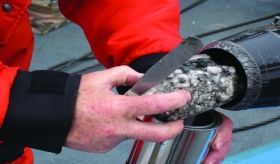After lying hidden in sediments for thousands of years, delicate frozen gas structures are in the spotlight for both scientific research and the national interest. These structures, known as gas hydrate, are being investigated by scientists the world over for their possible contributions to the global energy mix, as well as their potential interaction with the environment.
The number of discoveries and advances regarding gas hydrates has advanced at a rapid pace in recent years. As a leading voice in international gas hydrate research, the U.S. Geological Survey has contributed substantially to the discourse. Now, to take stock of where we are and what is known about gas hydrates, USGS has published two new fact sheets focused on methane hydrates.
The first fact sheet provides up-to-date information about naturally occurring gas hydrates, including their global distribution, the amount of gas trapped in these deposits, and the technology used to find them. The second fact sheet describes the USGS Gas Hydrates Project, which collaborates with other U.S. federal agencies, international partners, and academic researchers to enhance understanding of the resource potential of gas hydrates and the interaction of gas hydrates with the changing environment.
Continue reading at USGS.
Image via USGS.


